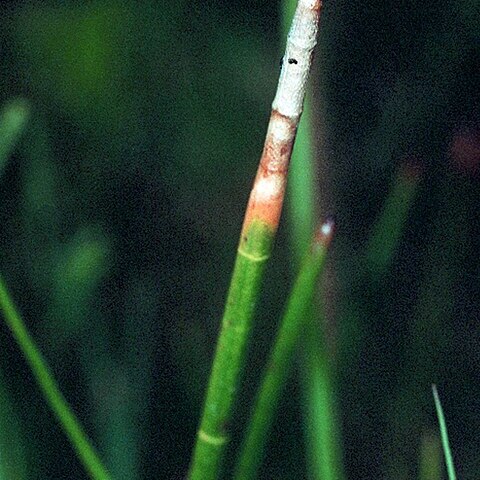Plants perennial; rhizomes 2–4 mm thick, soft to firm, longer internodes 2–8 cm, scales persistent, 7–8 mm, membranous, tubers absent. Culms terete, 50–100 cm × 5–8.4 mm, soft to firm, obscurely to clearly septate-nodulose throughout, internally hollow with complete transverse septa, closer together near the spikelet; plants never forming filiform, flaccid culms. Leaves: distal leaf sheaths persistent, membranous to thinly papery, apex acute to slightly acuminate. Spikelets not proliferous, 20–45 × 4–5(–8) mm; rachilla joints bearing prominent winglike remnants of floral scales; proximal scale empty, amplexicaulous, (2–)2.8–4.9 mm; floral scales 85–160, 1–3 per mm of rachilla, stramineous to pale brown, usually with pale to dark brown submarginal band, obovate to oblong, (4.8–)5.2–7 × 3–4.4 mm, cartilaginous, often membranous toward margins, margins broadly translucent, membranous, apex rounded to obtuse. Flowers: perianth bristles 3–8, stramineous to reddish, slender, vestigial to 2.5 mm, shorter than to equaling achene, smooth or obscurely retrorsely spinulose; anthers stramineous to red-striated, 2.6–3.2 mm; styles 2–3-fid. Achenes yellowish to reddish brown, obovoid, biconvex to obscurely compressed trigonous, 1.8–2.3 × 1.4–1.9 mm, obscurely sculptured or sometimes partially smooth at 10–15X, each face with 20–40 rows of linear, transversely elongated cells, lines separating cells obscure, apex with very short neck 0.6–0.8 mm wide. Tubercles dark brown, lamelliform, high-deltoid, 0.6–1.1 × 0.5–0.7 mm.
More
Rhizomatous perennial; stems to 1 m, 5 mm thick, cross-septate at intervals of 2–5 cm; spikelet cylindric, 1.5–3 cm, about as thick as the stem; scales oval, obtuse to broadly rounded, scarious-margined, purple-dotted inside; bristles few, crooked, weak, up to as long as the achene; style trifid or bifid; achene biconvex, obovoid, golden-brown, 2 mm; tubercle dark, flattened, triangular, 1 mm. Shallow water; near the coast from Mass. to Fla., w. to Wis., Mo., and Tex. (E. interstincta, misapplied)

